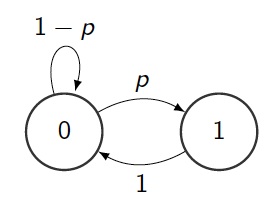Consider a strongly connected directed graph $G$. I have been stuck on the following question: can you assign real numbers in $[0,1]$ to each edge of $G$ so that the geometric mean of all cycles are equal? Also, I would like all outgoing edges to sum to 1.
For example, $p=\varphi^{-2}$ is a solution for the graph shown below, where $\varphi$ is the Golden ratio.
The geometric means for the two cycles are $(p\cdot1)^{1/2}=\varphi^{-1}$ and $(1-p)=(1-\varphi^{-2})=\varphi^{-1}$. The appearance of the Golden ratio here can be explained by observing the relation to sequences with no consecutive 1's (the number of such sequences of length $n$ is approximately $\varphi^n$).
Even though the number of constraints is much larger than the number of variables, I have not been able to construct a counterexample and I also don't know of a simple/direct proof of existence (I am aware of a purported indirect proof that exploits the ergodicity of the Markov chain - I would like to generalize this). I came across this question in my study of Markov chains. I have tried many numerical examples, and such a solution always exists (and is unique in my experience).
Any ideas, hints or references would be greatly appreciated!
Question is also on math.stackexchange (with some comments, but no answers).

